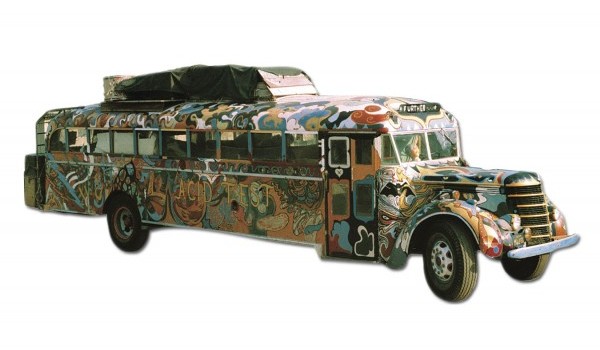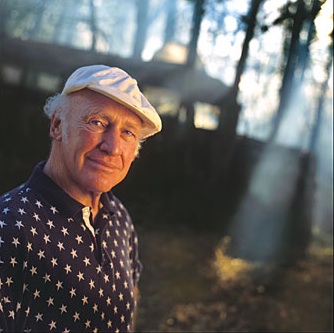Who Was Ken Kesey?
Novelist. Explorer. Prankster. Artist. Entertainer. Athlete. Teacher. Father. And so much more. Ken, the creator of the Furthur bus, was so many things to so many people. His influence on literature, art, and culture in the 20th Century is rivaled by few others. Perhaps best known for his 1962 best-selling novel, One Flew Over the Cuckoo’s Nest, Kesey’s impact spread far beyond literature. With his band of “Merry Pranksters” he often rubbed shoulders with numerous other musical and artistic powerhouses of his day. The Oregon Historical Society has called him “a founding father of the 1960s counterculture.”
The Early Years
He was born Kenneth Elton Kesey, September 17, 1935, in La Junta, CO, to Geneva and Fred Kesey. The family relocated to Oregon eleven years later, where Ken would spend the majority of his life. A superior athlete, Ken excelled at wresting in both high school and at the University of Oregon. Passionate about reading and films, Ken showed clear promise as a writer throughout his academic career. While still at the University of Oregon, Ken eloped with his childhood sweetheart, Norma “Faye” Haxby, and they remained married for the rest of his life. They had three children together: Jed, Zane, and Shannon. Ken also had another daughter, Sunshine, in 1966 with fellow Prankster, Carolyn “Mountain Girl” Adams.
Stanford and Beyond
Following graduation from Oregon, Kesey moved to California to attend the creative writing program at Stanford University. While there, he met numerous people with whom he formed lifelong friendships—Ken Babbs, Ed McClanahan, and Larry McMurtry, Wendell Berry, and others. It was also while at Stanford that he volunteered for experiments being conducted at the Menlo Park Veterans Hospital. Unknown to him at the time, these experiments where he was given psychoactive drugs, including LSD, were part of the CIA’s MKUltra project. After many experiences with LSD, Ken came to believe the substance had great positive potential. At a time when much of the US was focused on the Space Race, and exploring further and further away, Kesey saw psychoactives as tools for exploring inward, learning more about ourselves and others, and finding new ways to see the world already around us. With this belief at heart, Ken “liberated” some of the LSD from the veterans hospital and shared it with friends. He also used his experiences working at the hospital as the inspiration for One Flew Over the Cuckoo’s Nest, which became immediately successful upon its publication in 1962, providing Ken with fame and the financial freedom to continue to follow his heart—and his art.
The Acid Tests and Furthur
Predictably, the LSD experimentation and associated parties, which would come to be known as “Acid Tests,” grew in popularity. Largely because of this, the awareness of LSD spread throughout American culture. In 1963, Ken moved from Palo Alto to a house in the woods in La Honda, CA. The La Honda house became the “home base” for the Merry Pranksters, and the site of many Acid Tests. The “house band” was often The Warlocks, who would shortly become the Grateful Dead. It was 1964, while Ken was working on his second novel, Sometimes a Great Notion, when Ken got called to New York on work related to the book. He and the Pranksters decided to go together and made it a mission to see the World’s Fair, which was being held in the city that year. They purchased a 1939 International Harvester school bus, gave it the most psychedelic paint job the world had ever seen, and made the trip that would grow to become one of the most famous cultural journeys of modern times. Furthur was born, and become one of the most important historical, artistic, and cultural touchstones of the entire era.
In 1965, Ken ran into legal trouble for marijuana possession, after his return to California. After faking suicide and running away to Mexico, he returned to the Bay Area to face the charges. He served a short stint in the San Mateo County jail, and agreed to publicly denounce LSD. With a wink and a nod, he held the “Acid Test Graduation,” before leaving California and moving back to Oregon, where he settled on his Pleasant Hill farm.
Later Life
During the 70s, 80s, and 90s, Ken continued to write. In 1984, Ken suffered the loss of his son Jed in a tragic auto accident. Kesey continued to perform, though, often appearing on stage at Grateful Dead concerts. He also made a number of trips with the second version of Furthur—including one to England and another to the Rock and Roll Hall of Fame, in Cleveland—and performed his musical play Twister to numerous audiences on the West Coast. When he wasn’t traveling, performing, or writing, Ken spent his time working on the farm or enjoying the company of his extensive family and friends in the Eugene, OR area.
Ken Kesey died of complications from liver surgery on November 10, 2001, leaving behind legions of mourning fans, and a world forever changed for the better because he had been in it.
Learn More
Here are a few sources to help you learn more about Ken Kesey’s life, work, and art.
–Ken Kesey, Wikipedia
–Ken Kesey Biography, Oregon History Project
–Psychedelic 60s: Ken Kesey & the Merry Pranksters, University of Virginia Library
Tell Your Story
Did you ever meet Ken? Maybe you didn’t, but feel you were greatly impacted by him in some other way. We’d love to hear your stories and share them with others on this site. Please share your story about your experience of Ken and how he affected you.

